内蒙古科技大学图书馆检索中文数据库
内蒙古科技大学图书馆检索英文数据库
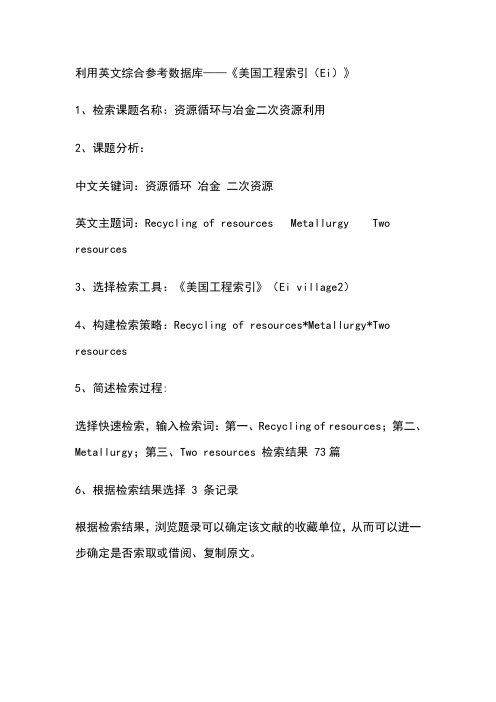
利用英文综合参考数据库——《美国工程索引(Ei)》1、检索课题名称:资源循环与冶金二次资源利用2、课题分析:中文关键词:资源循环冶金二次资源英文主题词:Recycling of resources Metallurgy Two resources3、选择检索工具:《美国工程索引》(Ei village2)4、构建检索策略:Recycling of resources*Metallurgy*Two resources5、简述检索过程:选择快速检索,输入检索词:第一、Recycling of resources;第二、Metallurgy;第三、Two resources 检索结果 73篇6、根据检索结果选择 3 条记录根据检索结果,浏览题录可以确定该文献的收藏单位,从而可以进一步确定是否索取或借阅、复制原文。
Search Results:73 articles found in Compendex for 1969-2014: ((((Recycling of resources) WN All fields) AND ((Metallurgy) WN All fields)) AND ((Two resources) WN All fields))1. Impact of recycling measures on resource- and energy efficiency and greenhouse gas emissions in the iron, steel and zinc industryBartusch, Hauke (Karlsruhe Institute of Technology, Institute for Industrial Production (IIP), Hertzstrae 16, 76187 Karlsruhe, Germany); Schwaderer, Frank; Alcalde, Ana Maria Fernández; Fröhling, Magnus; Schultmann, Frank Source: Proceedings - European Metallurgical Conference, EMC 2011, v 5, p 1539-1552, 2011, Proceedings - European Metallurgical Conference, EMC 2011Database: Compendex2. Recycling potentials of the two refractory metals tantalum and niobiumAngerer, Thomas (Montanuniversität Leoben, Department of Nonferrous Metallurgy, Franz-Josef-Strae 18, 8700 Leoben, Austria); Luidold, Stefan; Antrekowitsch, Helmut Source: European Metallurgical Conference, EMC 2013, p 1069-1084, 2013, European Metallurgical Conference, EMC 2013Database: Compendex3. Equipment and technology for recycling nonferrous metalsLuzgin, V.I. (Ural State Technical University, Ural Polytechnic Institute, Russ. Elec. Eng. Co. RÉLTEK); Petrov, A.Yu.; Timofeev, A.I. Source: Metallurgist, v 48, n 9-10, p 536-538, September 2004Database: Compendex阅读文摘:1. Impact of recycling measures on resource- and energy efficiency and greenhouse gas emissions in the iron, steel and zinc industryBartusch, Hauke1; Schwaderer, Frank1; Alcalde, Ana Maria Fernández1; Fröhling, Magnus1; Schultmann, Frank1Source: Proceedings - European Metallurgical Conference, EMC 2011, v 5, p 1539-1552, 2011, Proceedings - European Metallurgical Conference, EMC 2011; ISBN-13: 9783940276407; Conference: European Metallurgical Conference, EMC 2011, June 26, 2011 - June 29, 2011; Publisher:GDMB-InformationsgesellschaftAuthor affiliation:1 Karlsruhe Institute of Technology, Institute for Industrial Production (IIP), Hertzstrae 16, 76187 Karlsruhe, GermanyAbstract:Rising resource and energy prices as well as climate change have a significant impact on Germany's metal industry. Internal recycling of residues or external recycling in specialised processes are measures to meet these challenges by enhancing resource efficiency and decreasing the dependency on primary resources. As individual measures to increase efficiency become more and more complex, potentials to enhance the resource efficiency may exist if the focus is widened from a single plant to a network wide view. Residue flows can be the central element in such considerations. Steel production with Electric Arc Furnaces (EAFs) and Basic Oxygen Furnaces (BOFs) leads to zinc-bearing dusts. For these residues external recycling processes exist, which produce secondary zinc concentrates for the zinc industry. These material flows connect the processes of the steelmaking, recycling and zinc industry to a network. One possible approach to enhance resource efficiency network wide is a systematic search for external recycling options for materials which are currently disposed. Another possibility is to analyse different internal recycling rates under consideration of the effects on the connected internal and external processes. To evaluate theimpacts of internal and external recycling measures resource efficiency must be seen in context with the results on energy demand and CO2 emissions. Focussing on the residues from an EAF and a BOF this paper presents two example scenarios where actors of the iron and steel industry and the zinc industry are considered in an integrated way. Basing on simulation models of an example EAF, an integrated steelwork, a Waelz kiln, the DK Process and a hydrometallurgical zinc plant mathematical descriptions of the processes are obtained. Afterwards, a scenario analysis is carried out for a systematic examination of possibilities to increase resource efficiency under consideration of economic effects, energy consumption and CO2 emissions.(10 refs)Main heading: Iron and steel industryControlled terms: Basic oxygen converters - Carbon dioxide - Climate change - Complex networks - Computer simulation - Dust - Electric furnaces - Energy efficiency - Energy utilization - Gas emissions - Greenhouse gases - Metallurgy - Recycling - Steelmaking - ZincUncontrolled terms: BOF-dust - EAF-dust - Electric arc furnace - Mathematical descriptions - Recycling options - Resource efficiencies - Systematic searches - Zinc industryClassification Code: 804.2 Inorganic Compounds - 723.5 Computer Applications - 722 Computer Systems and Equipment - 546.3 Zinc and Alloys - 545.3 Steel - 545 Iron and Steel - 532.3 Electric Metallurgical Furnaces - 531.1 Metallurgy - 525.3 Energy Utilization - 525.2 Energy Conservation - 452.3 Industrial Wastes - 451.1 Air Pollution Sources - 451 Air PollutionDatabase: Compendex2. Recycling potentials of the two refractory metals tantalum and niobiumAngerer, Thomas1; Luidold, Stefan1; Antrekowitsch, Helmut1Source: European Metallurgical Conference, EMC 2013, p1069-1084, 2013, European Metallurgical Conference, EMC 2013; Conference: 7th European Metallurgical Conference, EMC 2013, June 23, 2013 - June 26, 2013; Sponsor: Recylex; Aurubis; Befesa; Berzelius Metall; Oschatz; Publisher:GDMB-InformationsgesellschaftAuthor affiliation:1 Montanuniversität Leoben, Department of Nonferrous Metallurgy, Franz-Josef-Strae 18, 8700 Leoben, AustriaAbstract:Tantalum and niobium are two outstanding elements of technological metals. Their applications are widespread and the substitution is only possible in few cases. Europe has no primary mining of the two chemical related elements, so the domestic industry is forced to process secondary raw materials in order to diminish dependencies on foreign raw material suppliers. The comprehensive analysis of material flow startsat the mining, followed by the processing of the ore and the reduction, goes beyond the further processing of diverse intermediate products up to the applications (end product). To find potential secondary resources for these two metals it's very important to know their main as well as the minor application areas and accordingly the whole production cycles of the different products. The scrap, generated during the production (pre consumer scrap) represents an important secondary source of raw materials. Post consumer scrap is also an attractive source but in many cases the lack of a recycling infrastructure hampers the use of it. Another complicacy is the dissipation of tantalum and niobium in the end products and so in the waste materials. In an economical view an extraction is not possible. If one or both metals are enriched in residuals of other recycling processes - e.g. indirect recycling of hard metal scrap - the recovering of niobium and/or tantalum could be an opportunity. Recycling in direction of the two refractory metals is a balancing act between technological and economical feasibilities and sustainable use. The study identifies potentials of secondary sources of Nb and Ta referring to their end products and discusses furthermore some established and newtechnologies for the processing of secondary raw materials.(63 refs)Main heading: Scrap metal reprocessingControlled terms: Metallurgy - Metals - Niobium - Ore analysis - Ore reduction - Ores - Raw materials - Recycling - Reduction - Refractory materials - Refractory metals - Scrap metal - TantalumUncontrolled terms: Comprehensive analysis - Economical feasibility - Intermediate product - Material Flow - Post consumer scraps - Raw material suppliers - Scrap - Secondary Raw MaterialsClassification Code: 951 Materials Science - 812.2 Refractories - 802.2 Chemical Reactions - 801 Chemistry - 549.3 Nonferrous Metals and Alloys excluding Alkali and Alkaline Earth Metals - 543.4 Tantalum and Alloys - 531.1 Metallurgy - 531 Metallurgy and Metallography - 505 Mines and Mining, Nonmetallic - 504 Mines and Mining, Metal - 502 Mines and Quarry Equipment and Operations - 452.4 Industrial Wastes Treatment and Disposal - 452.3 Industrial WastesDatabase: Compendex3. Equipment and technology for recycling nonferrous metalsLuzgin, V.I.1; Petrov, A.Yu.1; Timofeev, A.I.1Source: Metallurgist, v 48, n 9-10, p 536-538, September 2004; ISSN: 00260894; DOI: 10.1007/s11015-005-0021-2; Article number: 21; Publisher: Kluwer Academic/Plenum PublishersAuthor affiliation:1 Ural State Technical University, Ural Polytechnic Institute, Russ. Elec. Eng. Co. RÉLTEKAbstract:The capabilities of medium- and high-frequency induction furnaces developed by RE´ company for convertingnonferrous-metal wastes into a standard product were discussed. The use of two-frequency electromagnetic fields in refining and casting helps to recycle a wide range of metallic wastes in various states of aggregation. It also improves the chemical composition and homogeneity of the melt. The results show that the equipping the induction refining furnaces with casting modules gives maximum flexibility to obtained shaped castings and also makes them highly cost-effective means of recycling nonferrous-metal wastes and scrap.Main heading: Nonferrous metalsControlled terms: Aluminum alloys - Composition - Cost effectiveness - Electromagnetic field effects - Energy resources - Furnaces - Hydraulics - Impurities - Metal casting - Metal refining - Metallurgy - Rare earth elements - Raw materials - RecyclingUncontrolled terms: Ferrous metallurgy - Metallurgical processing - RE´LTEK company (CO) - Recycled products Classification Code: 801 Chemistry - 701.1 Electricity: Basic Concepts and Phenomena - 632.1 Hydraulics - 547.2 Rare EarthMetals - 541.2 Aluminum Alloys - 911.2 Industrial Economics - 534.2 Foundry Practice - 532 Metallurgical Furnaces - 531.1 Metallurgy - 525.1 Energy Resources and Renewable Energy Issues - 452.3 Industrial Wastes - 533.2 Metal RefiningTreatment: Theoretical (THR) - Experimental (EXP) Database: Compendex7、标示原文线索:用中文标示各检索结果的著录事项第一篇文献:一、篇名: Impact of recycling measures on resource- and energy efficiency and greenhouse gas emissions in the iron, steel and zinc industry二、第一责任者:Bartusch, Hauke三、第一责任者单位:Karlsruhe Institute of Technology, Institute for Industrial Production (IIP), Hertzstrae 16, 76187 Karlsruhe, Germany四、文献来源:Proceedings - European Metallurgical Conference, EMC 2011, v 5, p 1539-1552, 2011, Proceedings - European Metallurgical Conference, EMC 2011第二篇文献:一、篇名:Recycling potentials of the two refractory metals tantalum and niobium二、第一责任者:Angerer, Thomas三、第一责任者单位:Montanuniversität Leoben, Department of Nonferrous Metallurgy, Franz-Josef-Strae 18, 8700 Leoben, Austria四、资料来源:European Metallurgical Conference, EMC 2013, p 1069-1084, 2013, European Metallurgical Conference, EMC 2013 第三篇文献:一、篇名:Equipment and technology for recycling nonferrous metals二、第一责任者:Luzgin, V.I.三、第一责任者单位:Ural State Technical University, Ural Polytechnic Institute, Russ. Elec. Eng. Co. RÉLTEK四、资料来源:Metallurgist, v 48, n 9-10, p 536-538, September 2004。
基于文献检索课自主学习模式的网络教学平台建设——以内蒙古科技大学图书馆为例

学校教学改革 的要求 , 从 教学内容 到教 学方法 、 教 学手段等各方
面, 对原《 科技 文献检索与利 用》 课加以彻底 改造 后新开设 的一
门全校公共必修课 。这 门课从 2 0 0 6年 成为全校必修课 , 研究生
上课时 间为研一第一学期 , 本科生为大二下学期或大三上学期 , 高职生为大二上学期 。课程总学时为 2 4学时 , 理论 1 4学 时 , 实
重要 的是培养学生综合素质和能力 。信息素质的教育是在一定
理论支撑下着重于培养学生获取各种信息的综合能力 , 实战性 、
实用性较强 ,而传统 的教学方式主要是 以教师讲授为 中心 的教
学, 这种教学模式忽视了培养学生实际解决 问题 的能力。因此需 要构建师生平等互动 、 自主学 习的教学模式 , 这种教学模式在整 个 教学过程 中 , 教 师是 学生的指导者 、 启发 者及合作者 , 学生 在 教学过程 中是积极参与者 、 促进者 。通过营造开放 的信息数字化
分工合作式 的学习方式对培养大学 生的团结合作精神和科学的
思维方法及语言表达能力非常有效 ,同时也 锻炼 了学生和学生
之 间 以 及 和 老师 之 间 的交 流 沟通 能 力 。
习 8学时 , 结课 考试 2 学 时。上课 与实 习相结合 , 配备 了专业 的 信息检索实践机房和 电子教师 , 配备专 业教师队伍和教研室 , 采
基金项 目: 内蒙古科技 大学 2 0 1 0年教 学( 教改) 研 究立项
项目 “ 《 网络资 源与信 息检 索》 课 自主 学 习研 究” ( 项 目编 号 :
J Y 2 0 1 0 0 2 2 ) 。
5 0 李冰, 亢源自琦基于文献检 索课 自主学习模 式的网络教学平 台建设—— 以内蒙古科技大学图书馆为例
一、内蒙古科技大学图书馆介绍(1)
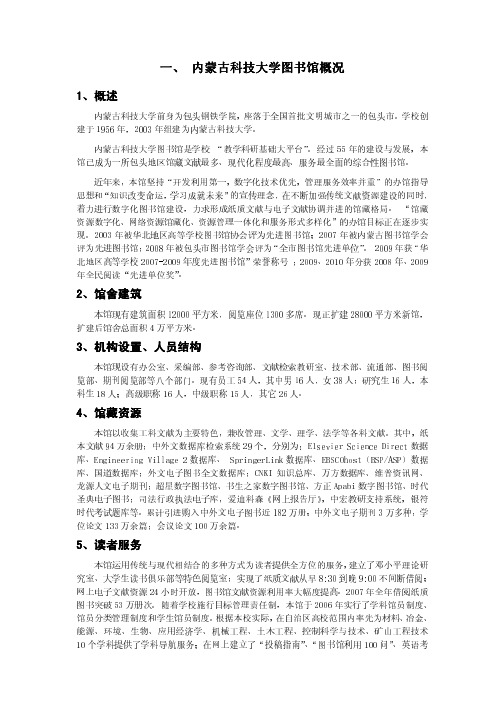
2009 年本馆申报《技术创新方法(TRIZ)培训推广的研究》,获内蒙古科技厅重点软科 学立项支持,合同资助二十万元。
7、信息素质教育与创新素质教育
本馆承担着全校学生信息素质教育与创新素质教育的教学任务,开设《网络资源与信息 检检索索》》课和教《学创研造究学改》、革《与发实明践创由新于设成计绩于显实著践,》获三得门2公00共5 选年修度课内程蒙。古其自中治,区《教网学络成资果源二与等信奖息, 并网从上演20示06教级学本相科结生合开、网始上被阅学读校讲定义为与公网共上必提修交课批。改该作课业程相开结创合了、内开科放大式“教课学堂与多研媒究体型教教学学与、 个内性科化大教赢学得了相广结合泛”的的好新评型和教荣学誉模。《式创。造为学高》校基公础共理课论开研设究类论似文课,程分提别供获了中成国功创的造范学例会,也200为6 “创优新设秀创计造 于实成果 践奖》课”、学20生08,“共优申秀报创实造用成新果型二专等利奖与”。外2观00设9计年专5利月以7 项来,,《已创授造权学3》项和。《发明
4、馆藏资源
本馆以收集工科文献为主要特色,兼收管理、文学、理学、法学等各科文献。其中,纸 本文献 94 万余册;中外文数据库检索系统 29 个,分别为:Elsevier Science Direct 数据 库库、、E国ng道in数ee据ri库ng;V外il文la电ge子2图数书据全库文、数据Sp库ri;ngCeNrKLIin知k 识数总据库库、、万EB方SC数Oh据os库t(、B维SP普/AS资P)讯数网据、 龙圣典源人电文子电图子书期;刊司;法超行星政数执字法图电书子馆库、,书爱生迪之科家森数《字网图上书报馆告、厅方》,正中Ap宏ab教i 研数支字持图系书统馆,、时银代符 时代考试题库等。累计引进购入中外文电子图书近 182 万册;中外文电子期刊 3 万多种;学 位论文 133 万余篇;会议论文 100 万余篇。
图书馆
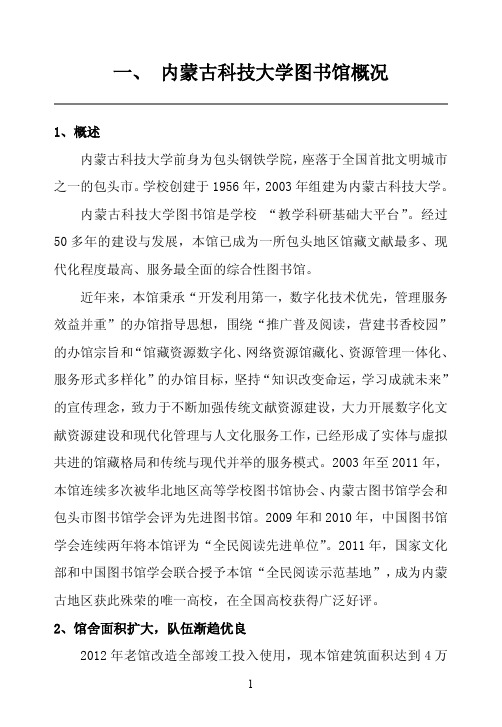
一、内蒙古科技大学图书馆概况1、概述内蒙古科技大学前身为包头钢铁学院,座落于全国首批文明城市之一的包头市。
学校创建于1956年,2003年组建为内蒙古科技大学。
内蒙古科技大学图书馆是学校“教学科研基础大平台”。
经过50多年的建设与发展,本馆已成为一所包头地区馆藏文献最多、现代化程度最高、服务最全面的综合性图书馆。
近年来,本馆秉承“开发利用第一,数字化技术优先,管理服务效益并重”的办馆指导思想,围绕“推广普及阅读,营建书香校园”的办馆宗旨和“馆藏资源数字化、网络资源馆藏化、资源管理一体化、服务形式多样化”的办馆目标,坚持“知识改变命运,学习成就未来”的宣传理念,致力于不断加强传统文献资源建设,大力开展数字化文献资源建设和现代化管理与人文化服务工作,已经形成了实体与虚拟共进的馆藏格局和传统与现代并举的服务模式。
2003年至2011年,本馆连续多次被华北地区高等学校图书馆协会、内蒙古图书馆学会和包头市图书馆学会评为先进图书馆。
2009年和2010年,中国图书馆学会连续两年将本馆评为“全民阅读先进单位”。
2011年,国家文化部和中国图书馆学会联合授予本馆“全民阅读示范基地”,成为内蒙古地区获此殊荣的唯一高校,在全国高校获得广泛好评。
2、馆舍面积扩大,队伍渐趋优良2012年老馆改造全部竣工投入使用,现本馆建筑面积达到4万平方米;各类阅览室近40个;普通阅览座位2376席,电子阅览座位541席,总计达到4000多席。
现设办公室、资源建设部、学科服务部、文献检索教研室、技术部、借阅部、期刊阅览部等七个部门。
不久将根据现代图书馆的管理模式,实行大部制。
现有正式员工59人中,其中研究生24人,占40%,本科生24人,占40%;高级职称17人占总人数29%,中级职称26人占总人数44%,队伍素质结构逐年明显提高。
3、文献逐年增加,资源类型丰富本馆以收集工科文献为主要特色,兼收管理、文学、理学、法学等各科文献。
其中,纸本文献102万余册;中外文数据库检索系统50多个,包括:Elsevier Science Direct数据库、Engineering Village2数据库、EBSCOhost(BSP/ASP)数据库、国道数据库;CNKI 知识总库、维普资讯网、博看期刊数据库;超星数字图书馆、方正Apabi数字图书馆、爱迪科森《网上报告厅》、新东方在线、北大法意网、方正中华数字书苑等;累计引进购入中外文电子图书376万种(册);各类中外文电子期刊3万多种;学位论文近170万篇;会议论文170万余篇。
维普全文数据库-内蒙古医科大学图书馆
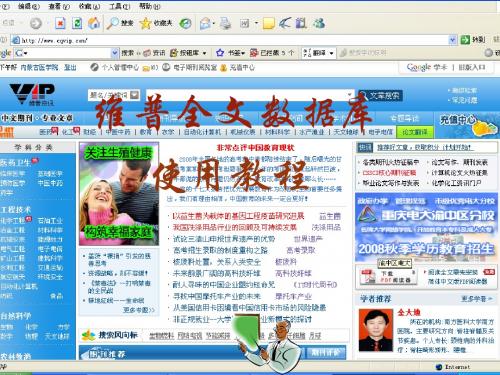
注册“我的数据库”
点击
定制“我的数据库”
可分别定制(最多可定制 20个)你所需的内容
期刊定制
我的主 页 集中显示定制内容,可直接点击某一定制 信息,得到相应的检索结果。
我的电子书架
保存在检索结果页面勾选的文章 注意: 1. 我的电子书架中最多能保存100条信息; 2. 电子书架中保存的文章可整理、删除;
我的检索历史
快速检索
检索区域
导航区域 概览区域
细览区域
1.选择检索途径(十种检索入口:关键词、作者、第一作者、刊名、
任意字段、机构、题名、文摘、分类号、题名或关键词)
2.限定检索范围(学科范围、年限、期刊范围及同义词库、同名作者库) 3.检索式和复合检索
1)利用“二次检索”
在第一次结果的基础上再次检索。
传统检索
同义词的功能
同名作者的应用
同义词的功能
同名作者的应用
分类检索
分类检索
检索栏
分 类 表
添加删 除按钮
Hale Waihona Puke 快速查找分类如果不勾选任何分类,则搜索全部记录!
分类检索结果
高级检索
查看同义词:比如输入土豆,点击查看同义词,即可 检索出土豆的同义词----马铃薯、马铃薯、洋芋,用 户可选择,以扩大检索范围。 查看同名/合著作者:输入某一作者姓名,点击查看同 名作者,即以列表形式显示不同单位同名作者,用户可 以选择作者单位来限制同名作者范围。 查看分类表:用户可以直接点击按钮,会弹出分类表 页。 查看相关机构:比如用户可以输入天津工业大学,点 击查看相关机构,即可显示以天津工业大学为主办 (管)机构的所属期刊及单位列表。 查看变更情况:比如用户可以输入刊名“财经窗 ”, 点击查看变更情况,系统会显示出该期刊的创刊名 “商业经济论坛”和曾用刊名“财贸论坛 ”。
基于馆藏数据的高校图书馆中文图书采访模式探析--以内蒙古科技大学图书馆为例
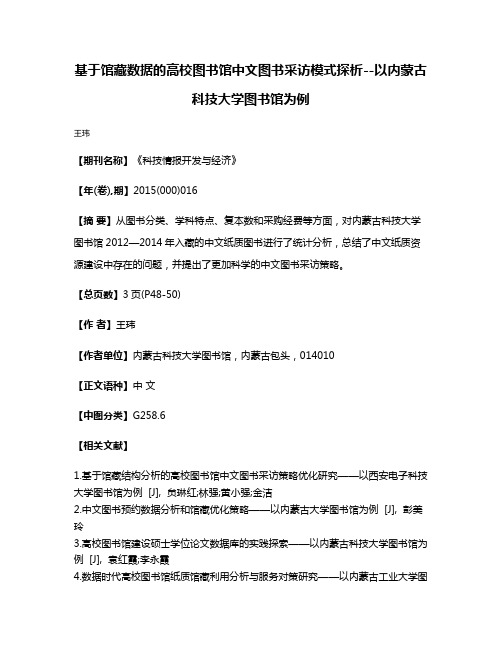
基于馆藏数据的高校图书馆中文图书采访模式探析--以内蒙古
科技大学图书馆为例
王玮
【期刊名称】《科技情报开发与经济》
【年(卷),期】2015(000)016
【摘要】从图书分类、学科特点、复本数和采购经费等方面,对内蒙古科技大学图书馆2012—2014年入藏的中文纸质图书进行了统计分析,总结了中文纸质资源建设中存在的问题,并提出了更加科学的中文图书采访策略。
【总页数】3页(P48-50)
【作者】王玮
【作者单位】内蒙古科技大学图书馆,内蒙古包头,014010
【正文语种】中文
【中图分类】G258.6
【相关文献】
1.基于馆藏结构分析的高校图书馆中文图书采访策略优化研究——以西安电子科技大学图书馆为例 [J], 贠琳红;林强;黄小强;金洁
2.中文图书预约数据分析和馆藏优化策略——以内蒙古大学图书馆为例 [J], 彭美玲
3.高校图书馆建设硕士学位论文数据库的实践探索——以内蒙古科技大学图书馆为例 [J], 袁红霞;李永霞
4.数据时代高校图书馆纸质馆藏利用分析与服务对策研究——以内蒙古工业大学图
书馆为例 [J], 郭俊平; 顾洁; 宋飞
5.高校图书馆中文图书回溯建库之探析
——以内蒙古工业大学图书馆为例 [J], 李勇
因版权原因,仅展示原文概要,查看原文内容请购买。
如何查阅资料

如何查阅资料一、学校数据库从学校主页进入图书馆主页:/从中我们可以许多数据库,一般大家现在用是中文资源(在主页中最左侧),常用的有以下几个①CNKI全文数据库:/kns50/index.aspx②万方数字化期刊/其他数据库大家可以根据自己需要去下载需要的资料,有空多关注图书馆的培训信息,每学期都有图书馆“1小时专题培训”安排,希望大家去听一下。
这是今年上学期的安排,下学期不要忘记了,关注下。
专题名称主讲人讲座简介时间与地点第一讲如何利用CNKI全文数据库查找资料丁兰兰主要介绍CNKI的期刊全文数据库与优秀硕博论文全文数据库3月22日15:30-16:30(星期四)图书馆三楼302室第二讲如何利用万方数据全文数据库查找资料吕元康主要介绍万方数据数字化期刊全文数据库与硕博论文全文数据库3月29日(星期四)15:30-16:30图书馆三楼302室第三讲如何利用手机、PAD等移动设备利用图书馆阮建成1.用户注册2.各种网络的使用技巧及上网4月9日(星期一)二、网上其他文库1.Google学术搜索/schhp?hl=zh-CN&as_sdt=0,5如你需要搜索关于“菲涅尔衍射”的相关论文,那么输入菲涅尔衍射filetype:pdf这些pdf格式基本都可以直接下载,英文文献也可是如此,不过并不是需要的文献都有Pdf供你下载,有些是不提供的。
2.新浪共享资料/(部分下载需注册)3.豆丁网/list.html(部分下载需注册)4.Baidu文库/(部分下载需注册)。
文献检索报告
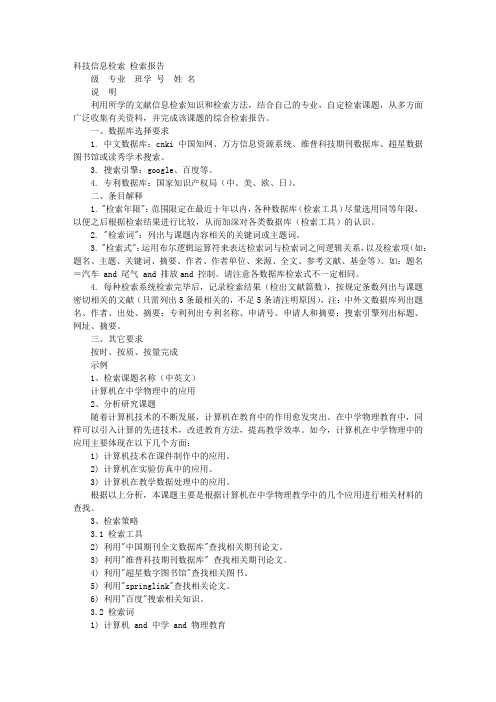
科技信息检索检索报告级专业班学号姓名说明利用所学的文献信息检索知识和检索方法,结合自己的专业,自定检索课题,从多方面广泛收集有关资料,并完成该课题的综合检索报告。
一、数据库选择要求1. 中文数据库:cnki中国知网、万方信息资源系统、维普科技期刊数据库、超星数据图书馆或读秀学术搜索。
3. 搜索引擎:google、百度等。
4. 专利数据库:国家知识产权局(中、美、欧、日)。
二、条目解释1. "检索年限":范围限定在最近十年以内,各种数据库(检索工具)尽量选用同等年限,以便之后根据检索结果进行比较,从而加深对各类数据库(检索工具)的认识。
2. "检索词":列出与课题内容相关的关键词或主题词。
3. "检索式":运用布尔逻辑运算符来表达检索词与检索词之间逻辑关系,以及检索项(如:题名、主题、关键词、摘要、作者、作者单位、来源、全文、参考文献、基金等)。
如:题名=汽车 and 尾气 and 排放and 控制。
请注意各数据库检索式不一定相同。
4. 每种检索系统检索完毕后,记录检索结果(检出文献篇数),按规定条数列出与课题密切相关的文献(只需列出5条最相关的,不足5条请注明原因),注:中外文数据库列出题名、作者、出处、摘要;专利列出专利名称、申请号、申请人和摘要;搜索引擎列出标题、网址、摘要。
三、其它要求按时、按质、按量完成示例1、检索课题名称(中英文)计算机在中学物理中的应用2、分析研究课题随着计算机技术的不断发展,计算机在教育中的作用愈发突出。
在中学物理教育中,同样可以引入计算的先进技术,改进教育方法,提高教学效率。
如今,计算机在中学物理中的应用主要体现在以下几个方面:1) 计算机技术在课件制作中的应用。
2) 计算机在实验仿真中的应用。
3) 计算机在教学数据处理中的应用。
根据以上分析,本课题主要是根据计算机在中学物理教学中的几个应用进行相关材料的查找。
- 1、下载文档前请自行甄别文档内容的完整性,平台不提供额外的编辑、内容补充、找答案等附加服务。
- 2、"仅部分预览"的文档,不可在线预览部分如存在完整性等问题,可反馈申请退款(可完整预览的文档不适用该条件!)。
- 3、如文档侵犯您的权益,请联系客服反馈,我们会尽快为您处理(人工客服工作时间:9:00-18:30)。
1、检索课题名称:促进我国自主创新的知识产权管理研究
2、课题分析:“知识产权管理”是本课题中的主体,“自主创新”是限定“知识产权管理”的内容,而“研究”“促进”是修饰内容,“知识产权管理”能提高我国的“自主创新”,因此“研究”“促进”“我国”都不可作为检索词,由此得出如下检索词:
中文关键词:1、知识产权管理2、自主创新
英文关键词:1、Intellectual property management 2、Independent innovation
3、选择检索工具:(1)CNKI硕士论文库(2)维普期刊数据库
4、构建检索策略:因“知识产权管理”为课题的主体,应优先检索,“自主创新”应在检索结果中同时存在。
所以制定如下检索策略。
“()”表示优先、“*”表示并且。
检索算法:(知识产权管理)*自主创新
时间范围:2005-2014
文献范围:期刊论文、硕士论文
5、简述检索策略调整的过程:
1)在CNKI硕士论文库中:
a、为保证查全率,使用“(知识产权管理)*自主创新”检索运算式,检索范围选择:所有专辑、全文中检索,检索出记录2,644条。
b、上述检索策略得到的检索结果2,644条过多,考虑缩小检索范围。
改全文检索项为关键字检索。
使用“(知识产权管理)*自主创新”检索运算式,检索范围选择:所有专辑,关键字中检索,检索出记录3条。
c、上述检索策略得到的检索结果3条太少,考虑扩大检索范围。
改关键字检索改为摘要检索。
使用“(知识产权管理)*自主创新”检索运算式,检索范围选择:所有专辑,摘要中检索,检索出记录40 条,数量稍多。
d、在摘要检索的基础上增加年份限制,检索2010-2014年的论文,检索出记录22条,数量适中。
2)维普期刊数据库:
a、用“维普期刊数据库”检索文献,使用“(知识产权管理)*自主创新”检索运算式,题名或关键词检索,不限定年代,检索出记录52条。
b、上述检索策略得到的检索结果52条数量偏多。
使用“(知识产权管理)*自主创新”检索运算式,题名或关键词检索,考虑检索加入年限,2005-2014年,适当的减少检索出的数量,检索出记录49条。
数量偏多。
c、采用题名检索,年限2005-2014年,“(知识产权管理)*自主创新”检索运算式,检索出记录9篇。
数量适中。
6、整理检索结果:
(1)CNKI硕士论文库(选1 条):
我国知识产权政府管理问题对策研究
【作者】邹芸潞;
【导师】伍玉林;
【作者基本信息】哈尔滨理工大学,科学技术哲学,2013,硕士
【摘要】随着科学技术的发展和市场竞争的加剧,知识产权在经济生活中的地位日益突显。
国家对于知识产权为科学技术的创新以及经济社会的发展所带来的巨大推动作用越来越重视。
这就要求我国在不断促进自主创新的同时,加强知识
产权管理。
加强知识产权管理是现时代的必然要求,也是中国实施“科教兴国”战略、建设“以人为本”的和谐社会所必须面对和解决的一个重大课题。
而加强知识产权的政府管理,对于落实科学发展观、建设社会主义和谐社会更有着重要的现实作用。
本文在比较和分析相关文献资料的基础上,系统论述了我国知识产权政府管理的相关问题以及解决对策。
通过对研究背景、目的、意义等阐述,进一步明确了研究方向;通过对知识产权政府管理的国内外研究现状分析,掌握了开展研究的理论基础。
从知识产权、知识产权管理的含义入手,引入知识产权政府管理的概念,结合我国知识产权政府管理的现状,分析其存在的问题,在借鉴发达国家政府知识产权管理中的先进经验的基础上,进一步提出完善我国知识产权政府管理的对策和建议。
本文认为要有效地实施国家知识产权战略,完善我国的知识产权制度,必须正确发挥政府的作用,把政府的宏观调控同市场的价值规律有机的结合起来,进而充分发挥...
【关键词】知识产权;知识产权管理;政府管理;
(2)维普期刊数据库(选1 条):
加强知识产权管理提升企业自主创新能力
【作者】焦书浩李东王飞刘春平
【机构地区】中国石油天然气集团公司通信公司
【出处】《石油科技论坛》2011年第30卷第6期9-10页,共2页
【摘要】文章介绍了中国石油天然气集团公司通信公司在知识产权管理及知识产权获取、保护和运用等方面的情况和经验,如必须明确知识产权工作思路,不断完善知识产权管理体系,有效提升全员知识产权保护意识,把知识产权保护融入企业创新全过程,以及在知识产权获取与保护方面要讲究策略等。
公司在知识产
权保护方面做出了卓有成效的工作,5年来公司已申报国际发明专利2项、中国专利99项,取得软件著作权6项,并被评为河北省知识产权优势培育单位,获国家知识产权局企业知识产权战略成果三等奖。
【关键词】创新能力核心竞争力知识产权
7、标示原文线索:
(1)题目:我国知识产权政府管理问题对策研究
【作者】邹芸潞;
【机构】哈尔滨理工大学
【作者基本信息】哈尔滨理工大学,科学技术哲学,2013,硕士
(2)题目:加强知识产权管理提升企业自主创新能力
【作者】焦书浩李东王飞刘春平
【机构地区】中国石油天然气集团公司通信公司
【刊名】石油科技论坛2011年6期。
